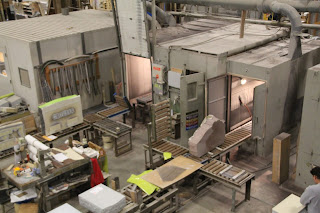Passed grout piles. Grout is a Scottish word for waste. Originally they used black powder dynamite in the quarry and half if each piece was wasted. Piles look like a dump. They often find uses for some of it. After Hurricane Irene four years ago, it was used for restoring landscaping, in blacktop, and in rebuilding a breakwater in Buffalo.
Four small villages were built near the quarry so the workers could walk. They came from England, Scotland, Italy and Canada, mainly. Boarding houses and apartments were built. We passed a Catholic Church that was built in 1895, using this granite for the foundation and retaining walls.
We arrived at the quarry. So far they've gone down 600', but they know it is 10 miles deep and that there is enough granite for the current level of sales to last 4500 years. The green water is the run-off from the saws and discolors because of the granite dust.
The granite weighs 168 pounds per cubic foot. It is easiest to take out 25 ton blocks. The derricks remove the granite, move equipment and workers (inside a rider's box). Originally they used some made from wood from Oregon and Washington, but then steel ones. Guy wires stabilize them Every Friday afternoon a rigger climbs them and greases all of the cables!
There are 380 men on this site. Women have worked here before. 30 men are up here. The positions are unionized- Steel workers' and others. They work out here 9 months of the year. It is too unhealthy and unsafe during the worst 3 months of winter. They work 40 hours, making $25-35 per hour. Receive unemployment on the off months and their benefits continue. Most have worked here 8-10 years and many are second generation. There are also engineers and architects.
The high school has tech classes and much of the work is learned through internships on the job.
Some blocks are 25' thick, 30' x 40', and weigh 1200-1400 tons-the weight of 3 fully loaded 747's. The blocks are all shipped out by semis. When we left here we saw one with 2 blocks on it.
Pneumatic drills are used to remove the block, industrial diamonds, carbide chips, and water. Workers used to contract silicosis, but using water has prevented that.
To the left of the cables is a road. There are 3 pickups parked at the end closest to us, but they are miniscule compared to the granite.
These are completed blocks. They each have a location number showing where they came from in the quarry and an inventory number. If someone was going to have something huge made, they would find pieces that were from the same location and with similar inventory numbers so they would match closely.
Inside the plant where items are made from the granite-mostly burial markers, headstones, mausoleums, etc.
The guide showed us two pieces of black granite on the ground that is from another one of their quarries and is like that used to make the Vietnam Wall. Some of theirs was used in the WWII memorial. The Korean memorial was designed by a local man and he used local men as the subjects for the soldiers faces.
Near the center of the picture there is a large rectangular piece of granite in brown. We watched two men bring a crane down from the ceiling which turned the stone over. As it turned, we could see it had been etched with words on one side.
There are sculptors and carvers. Some who wash the finished project. Those who transfer the inscriptions onto the stone. We were on a walkway up above and below us was a conveyor belt lined with pieces, each having a piece of paper with instructions on it about the inscription. A blacksmith makes some parts, just like in the 1880's. Someone makes the wooded crates for shipping pieces. Pieces go into a sand blaster on a conveyor belt.
Some pieces are sent to a business in town for polishing for pieces that company makes. This isn't a granite full of designs like what is used for countertops.
Near the center of the picture there is a brown piece of granite. We watched 2 men lower a crane from the ceiling, attach it to that huge stone, and turn it over. We could see that the top had been inscribed as it turned over.
HOPE CEMETERY
There are beautiful headstones, family markers, and mausoleums. Some had designs carved into the stone. Their granite holds up better than some others and its color doesn't run or blacken.
I'm sure this man was a sculptor at the granite plant.
We ate a picnic lunch at a city park. An old bridge connected the park to
some trails across the stream





















No comments:
Post a Comment